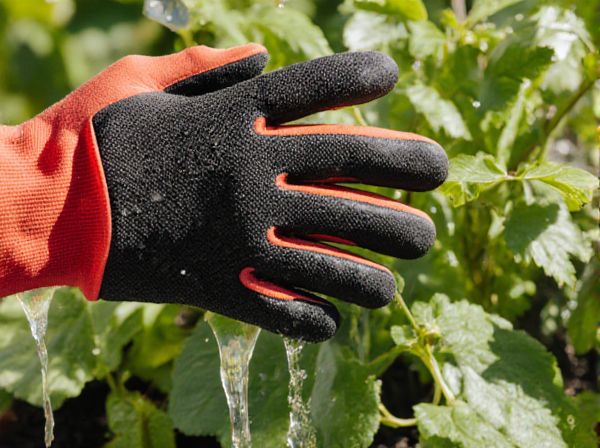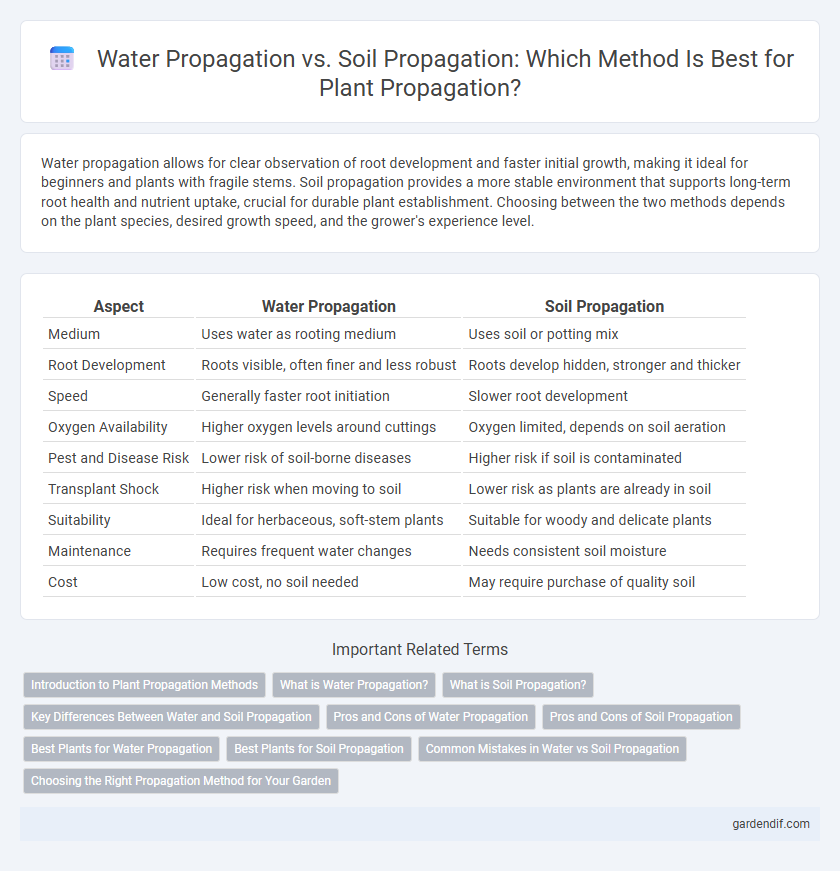
Water Propagation vs Soil Propagation Illustration
Water propagation allows for clear observation of root development and faster initial growth, making it ideal for beginners and plants with fragile stems. Soil propagation provides a more stable environment that supports long-term root health and nutrient uptake, crucial for durable plant establishment. Choosing between the two methods depends on the plant species, desired growth speed, and the grower's experience level.
Table of Comparison
| Aspect | Water Propagation | Soil Propagation |
|---|---|---|
| Medium | Uses water as rooting medium | Uses soil or potting mix |
| Root Development | Roots visible, often finer and less robust | Roots develop hidden, stronger and thicker |
| Speed | Generally faster root initiation | Slower root development |
| Oxygen Availability | Higher oxygen levels around cuttings | Oxygen limited, depends on soil aeration |
| Pest and Disease Risk | Lower risk of soil-borne diseases | Higher risk if soil is contaminated |
| Transplant Shock | Higher risk when moving to soil | Lower risk as plants are already in soil |
| Suitability | Ideal for herbaceous, soft-stem plants | Suitable for woody and delicate plants |
| Maintenance | Requires frequent water changes | Needs consistent soil moisture |
| Cost | Low cost, no soil needed | May require purchase of quality soil |
Introduction to Plant Propagation Methods
Water propagation accelerates root development by providing a consistent moisture environment, ideal for soft-stemmed plants and cuttings. Soil propagation offers a natural setting where roots establish directly in nutrient-rich mediums, promoting stronger plant adaptation. Selecting between water and soil propagation depends on plant species, growth speed, and environmental conditions.
What is Water Propagation?
Water propagation involves placing plant cuttings in water to encourage root development before transplanting them into soil, promoting faster root growth and easy monitoring of root health. This method is ideal for many houseplants such as pothos, philodendrons, and monsteras, as it reduces soil-borne diseases and allows for higher success rates. Water propagation provides a clean, simple environment that accelerates the initial rooting phase compared to traditional soil propagation.
What is Soil Propagation?
Soil propagation is a method of plant reproduction that involves planting cuttings directly into nutrient-rich soil to encourage root development. This technique leverages the natural composition of soil, including microorganisms, moisture retention, and aeration, to support robust root growth and healthy plant establishment. Compared to water propagation, soil propagation often results in stronger, more resilient plants due to improved nutrient uptake and environmental stability.
Key Differences Between Water and Soil Propagation
Water propagation enables faster root development and easier monitoring of root growth compared to soil propagation, which fosters stronger root systems due to natural soil microbes and nutrients. Soil propagation promotes greater plant stability and long-term growth success but requires more careful moisture control to prevent rot. Selecting water versus soil propagation depends on the plant species, growth goals, and environmental conditions to optimize rooting efficiency and plant health.
Pros and Cons of Water Propagation
Water propagation offers rapid root development and easy monitoring of root growth, making it ideal for propagating plants like pothos and philodendrons. However, prolonged exposure to water can lead to weaker stems and increased risk of root rot if water quality and oxygen levels are not properly maintained. While water propagation allows for quick observation, soil propagation typically provides more stable nutrient access and stronger root systems for long-term plant health.
Pros and Cons of Soil Propagation
Soil propagation offers the advantage of providing essential nutrients and stable moisture retention, promoting robust root development for plants. However, it may face challenges such as higher risk of soil-borne diseases and slower root growth compared to water propagation methods. The natural environment of soil fosters stronger, more resilient plants but requires careful monitoring of moisture levels and soil quality to ensure successful propagation.
Best Plants for Water Propagation
Best plants for water propagation include pothos, philodendron, spider plants, and coleus due to their ability to develop strong roots in water quickly. These species thrive in water propagation because their stems contain high moisture content and root easily from cuttings placed in water. Water propagation also allows for easy monitoring of root growth, making it ideal for houseplants with soft stems and rapid root development.
Best Plants for Soil Propagation
Best plants for soil propagation include tomatoes, peppers, and beans due to their strong root development and resilience in soil. Unlike water propagation, which suits plants like pothos and philodendron, soil propagation promotes better nutrient uptake and reduces transplant shock. Plants such as herbs like basil and rosemary also thrive with soil propagation, making it a preferred method for many gardeners aiming for robust growth.
Common Mistakes in Water vs Soil Propagation
Common mistakes in water propagation include neglecting to change the water regularly, which can lead to bacterial growth and root rot, and using non-sterile containers that introduce contaminants. In soil propagation, overwatering often causes poor aeration and root decay, while compacted or poorly draining soil hinders root development. Understanding these errors ensures higher success rates in propagating plants through either water or soil methods.
Choosing the Right Propagation Method for Your Garden
Water propagation allows for direct observation of root development, making it ideal for monitoring progress and diagnosing issues early, while soil propagation encourages stronger, more resilient root systems suited for long-term plant health. Plants with delicate or thin stems, such as pothos and philodendrons, often thrive in water, whereas woody or hardy species like tomatoes and peppers benefit more from soil propagation. Selecting the appropriate method depends on the plant species, growth goals, and environmental conditions to optimize successful rooting and growth.
Water Propagation vs Soil Propagation Infographic

 gardendif.com
gardendif.com